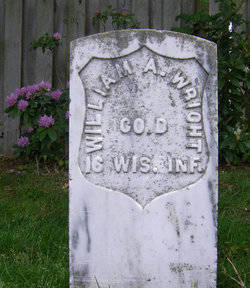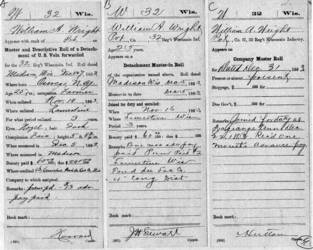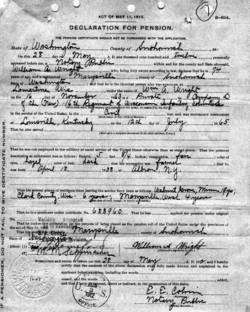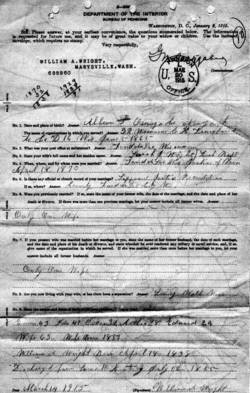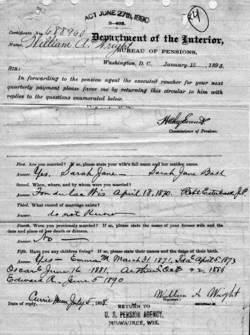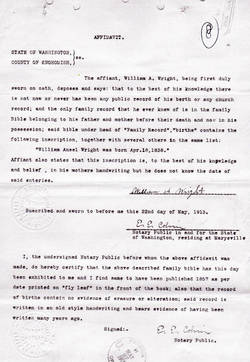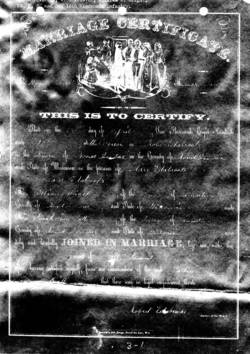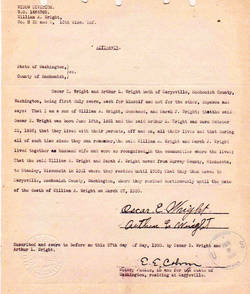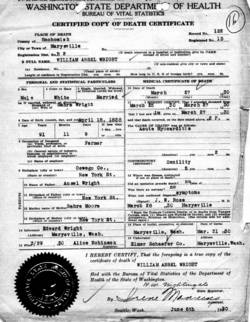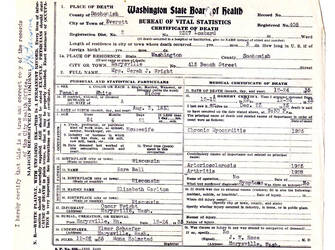William A. Wright
Representing: Union
G.A.R Post
- John Buford Post #89 Everett, Snohomish Co. WA
Unit History
- 32nd Wisconsin Infantry H
- 16th Wisconsin Infantry D
Full Unit History
32nd WISCONSIN VOLUNTEER INFANTRY
Organized: Summer/Fall, 1862 Camp Bragg Oshkosh, WI
Mustered In: 9/25/62 Camp Bragg Oshkosh, WI
Mustered Out: 6/12/65 Crystal Springs, MD
16th WISCONSIN VOLUNTEER INFANTRY
Organized: November, 1861 Camp Randall, Madison, WI
Mustered In: 1/31/62 Camp Randall, Madison, WI
Mustered Out: 7/12/65 Louisville, KY
Regimental History
REGIMENTAL HISTORY: (32nd)
The 32nd, a three-year "western theater" regiment was mustered into Federal service on 9/25/62 and left the state of Wisconsin on October 30th of that same year. It reached Memphis, TN on 11/3 and joined Union Gen. William T. Sherman's movement towards Vicksburg, MS. With the Union defeat at Holly Springs, MS Sherman's advance was cancelled and the 32nd returned to Memphis where it acted as provost guard (military police) until November when it moved to LaGrange, reaching Moscow on 12/3 just time to repulse the enemy's attack on Hatch's cavalry.
January, 1864. The 32nd was sent to Vicksburg, MS from whence it took part in the Meridian expedition. During that movement it held a pontoon bridge at Jackson until Union troops had passed then destroyed it.
In February, '64, while destroying portions of the Mobile & Alabama Railroad the 32nd was attacked by a brigade of Rebel cavalry. During this engagement the attackers were repulsed handsomely.
The regiment retuned to Vicksburg in March and then moved to Memphis, TN, Cairo, IL and Paducah, KY via 200 miles of the Tennessee River. Landing at Crump's Landing the regiment moved across Tennessee to Decatur, AL where it was engaged in guard duties and building fortifications.
Companies "A", "C", "D" and "F", plus a small additional force, engaged in a sharp skirmish with a large body of enemy troops in May and was compelled to fall back. The following day the Union group, assisted by artillery and cavalry, pursued the Rebels for seven miles. Those units of the 32nd, being in the brigade forefront, met a portion of the enemy forces and drove them into their main body where, with an impetuous charge, completely routed the insurgents. Before returning to camp the regiment also dispersed a small body of Rebels near Courtland.
Also, near Courtland, while guarding a wagon train in July the unit was attacked by a superior force, but repeatedly repulsed the enemy. The train was then safely escorted into camp. The following day it was engaged during the action which forced the enemy from his Courtland fortifications.
Next stop for the 32nd was Sherman's army within the siege of Atlanta, GA during which it was constantly under fire until the 24th of August. Next came the battle of Jonesboro then, picket and guard duty until October. In November the regiment joined the march toward Savannah, destroying the railroads and public property while skirmishing the Rebels at Ogeechee and Marlow.
The City of Savannah being captured by the end of 1864, the 32nd remained in that area until January 3, 1865, when the campaign northward through the Carolinas was begun. During those movements, after a day long struggle, the regiment forced the enemy from his works at Rivers' Bridge. Fifty one men were lost during this engagement, alone. This scenario was repeated at Binnaker's Bridge SC on 2/9/1865 after which, on March 3rd, Rebel forces were forced back at Cheraw SC. heavy skirmish work faced the 32nd at Cape Fear River and, at Bentonville, NC the regiment advanced through a swamp, charged the enemy and captured their works. That action essentially ended combat duties for the 32nd.
The regiment lastly participated in the Grand Review in Washington, D.C. It was mustered out of existence in June of 1865.
REGIMENTAL HISTORY: (16th)
Note: After the "official" ending of north/south hostilities in May, 1865, the U.S. Government moved to save funds by eliminating or consolidating certain military regiments. As the veteran profiled herein served in the 16th only on paper after the 32nd and that unit was consolidated, the war history of the 16th is not being presented.
Soldier History
SOLDIER: 32nd
Residence: Lamartine, Fond du Lac Co., WI Age: 25.6 yrs.
Enlisted/Enrolled: 11/14/63 Lamartine, Fond du Lac Co., WI Rank: Pvt.
Mustered In: 12/5/63 Madison, WI
Transferred Out: 6/4/65
Highest Rank: Pvt.
SOLDIER: 16th
Residence: Lamartine, Fond du Lac Co., WI Age: 27.2 yrs.
Transferred In: 6/4/65
Mustered Out: 7/12/65
Highest Rank: Pvt.
Family History
PERSONAL/FAMILY HISTORY:
William Ansel Wright was born April 18, 1838, in Albion, Oswego County, New York. His father was Ansel Wright. Unclear is whether the elder Ansel was born in New York in 1812 or circa 1822. The U.S. Census for 1840 noted Ansel as residing in Albion, but listed no birth year for him. It did not even list other family members in the household. A decade later, the 1850 census placed Ansel and family in Two Rivers, Manitowoc County, Wisconsin. That tally noted he was a merchant twenty eight years of age. This would place his year of birth around 1822. However, the census for 1860 of Lamartine, Fond du Lac County, Wisconsin listed Ansel, a farmer, as having been born in 1812 in New York State.
Available information on William's mother is also unclear. As noted above, in 1838, the year of William's birth, she was identified as Sahre/Sarah - nee Moore - Wright. No birth year is provided. Again, as above, the census for 1840 does not list members of Ansel's family, including his wife. In 1850, his wife's name is provided, but rather than Sahra/Sarah it is given as Malinda with an age of thirty one years which would place her birth date in 1819. The 1819 birth year is corroborated by the 1860 census wherein the name Marinda is again provided as well as her state of birth which was New York. 1819 is also the birth year provided by latter generation family member. Family lore also says her first name was Salvia; her second Malinda. In conclusion, we will accept ‘William’s mother’s name as Sarah Malinda (nee Moore).
As far as is known, William was the eldest of four Wright children born to Ansel and his wife. The younger siblings were: Mary (b. 1842 NY), Maria (b. 1852 WI) and Arthur (b. 1859 WI). As evidenced by the birth states of the younger children, at some point between 1842 and 1852 the Wright family had quitted New York for Wisconsin. In the latter state Ansel's occupation was noted in 1860 as "farmer."
By 1860 William was no longer residing under his parents’ roof. Where he was living at the time of that census is not known, but in late 1863 he was residing in Lamartine, Fun du Lac, WI. There, with the United States embroiled in a bloody civil war, William left farm life to volunteer in the U.S. Army infantry. Likely, that move was at least partially motivated by receipt of a $300 enlistment bonus or "bounty." In a day and age when wages were low and the monthly earnings of a private soldier were $13, this was a kingly sum. As for payment of that bonus/bounty, $60 was paid at the time of a soldier's official entry or "muster" into Federal service with the balance to incrementally to be received later.
Regarding Private Wright's entrance into the service, his vital statistics at the time were noted as follows: 5' 8 3/4", fair complexion, hazel eyes and dark hair. As previously noted, his occupation was farming. His enlistment/muster was credited to the 4th Congressional District of Fond du Lac County, WI.
William joined his company and regiment in the field on December 22, 1863 at or near La Grange, TN. Shortly thereafter, as was not unusual for the times, in January or February, 1864 he ended up in the hospital at Memphis, TN. As the cause for the hospitalization and the length of the stay are not noted, the former was likely not extremely serious nor the stay extremely lengthy. Beyond the hospitalization, the only other notation regarding Private Wright in 1864 was that in November or December when he received a pay stoppage of $2.50 for loss of a shelter tent half.
Early in 1865, though, Private Wright ran into a snag which lead to his being brought up before a regimental court martial (trial) and fined $26 - two months’ pay. Again, the details of this happening are not provided, so the originating act must have not been of an extreme or serious nature. If that would have been the case, he could have been called before a general court martial board. With this occurrence behind him, William's remaining months of soldiering remained benign. In terms of his separation from the service, it is interesting to note that Private Wright, after financially settling up his clothing and armament account and receiving his final bonus/bounty monies, "purchased his rifle and accoutrements." Such was not a common occurrence.
Army life behind him, William Wright retuned to Fond du Lac County, Wisconsin where he likely resettled in the community of Lamartne. It was in that town and county that, on April 18, 1870 he married to Sarah Jane Ball (b. 1851 WI). It was also in Lamartine that the 1870 census found farmer William and his nineteen year old bride who would ultimately bear him five children: Emma M. (b. 3/31/71 WI), Ida E. (b. 4/5/73), Oscar E. (b. 6/21/81 WI), Arthur L. (b. 10/22/86 MI) and Edward R. (b. 1890 MI). As with his nuclear family, the birth places of his own children show that William moved - in this case from Lamartine, Wisconsin to Minnesota - during child producing years. The year of the Wright's moved from Wisconsin to Murray County, Minnesota has been registered as 1882. Another source, however, alludes to 1884. While it has not been documented because of a lack of census data for 1890, their community of initial residence in Minnesota was likely Halloy. That was where the farming family composed of William, Sarah and their three sons were found during the 1900 population tally.
After residing in Minnesota for around twenty years, sometime in 1901/'02, for an undisclosed reason, the Wrights moved back to Wisconsin where they settled in Clark County. Residential locations mentioned within that county include Stanley and Thorp. It was from the latter community that the Wrights made their next move in in 1908/1909. That move, the final for the family, was to Marysville, Snohomish County, Washington. Exactly why it was made and what William's occupation - if any - became once he arrived there is not known.
The census for 1910 in Marysville noted that Union Army veteran William, then 72 years of age (check), was not employed. His income was from a U.S. Government pension which stemmed from his Civil War soldiering days. Exactly when that pension was granted and how much the monthly stipend was as of 1910 is not documented. Also in the home with him were wife Sarah, sons Oscar, Arthur and Edward, plus a grandson - Lemurel Rodguer - aged nine. Further, this tally noted that Sarah had borne five children, all of whom were living. The same would said by her in March of 1915.
The decade of the 1920s.That ten year period opened with a new census which found William and Sarah residing in Marysville. No other individuals were, at that time, noted as being part of the household. The next '20s entry pertaining to the wrights was on March 26, 1922 Sarah, then approximately seventy years of age, fell and fractured one of her hips. There are some indications that she never fully recovered from this accident. Finally, came an April 11, 1929 affidavit pertaining to William's condition as provided by another Marysville Civil War veteran, Enoch Sanderlin. (unit - died - buried Marysville comm. cem.) Sanderlin, a member of nearby Everett, Washington Buford Post #89, Grand Army of the Republic - of which Wright was not a member - wrote as follows: "(I) wanted him to join while he could get around, but he didn't. Now he unable to get around. (He) can't help himself at all. (He) has to be helped on and off his bed. When he is propped up he is able to sit in a chair a little while, but he is not able to walk. I don't think he is able to stand on his feet. I believe he had a stroke or paralysis or something which affected his legs. He also has something in the nature of tis, as I am informed, though I have not seen him have one. I am informed he fell on the street some two years ago in one of those fits and a(t) such times as he has ventured on the streets during the last two years his son has led him around......I can testify to that having seen it. My information is that he is a year or two older than I (Sanderlin was 90 years of age at the time). Our GAR post is at Everett. I am chief Patriarch Instructor, also Chaplin....I am depended upon to look after the comrades of this village although I don't consider myself a member of the visiting committee. If there is such a committee, I assume I am it. (I have visited) Comrade Wright quite often during the past two or three years and since he has been down bed-fast I have visited him on an average of every two weeks. I visited him last week and the week before and intended to visit him today, but met his son and caretaker on the street and made inquiry about the old gentleman, but did not go visit him today. When did he get down bed-fast? That was about (the first of) June of this year. It is my belief and best knowledge that he has not been able to leave his bed without someone to assist him. Was there something (that) occurred to cause or brings on a sudden change in his condition; I don't know it was he had a fall in which he was hurt or injured about that time. He is not able to perform such acts as dress or undress himself nor attend to the calls of nature without aid or assistance. I don't know whether he eats his meals at the family table or with other members of the family....He is not totally blind. I regard his mentality as impaired (to) some extent. One or two times when I called upon him he seemed unable to recall or recognize me."
Former Civil War infantry soldier William Ansel Wright died in Marysville on March 27, 1930. At passing he was 91.11 years of age. Cause of death for the retired farmer was "acute myocarditis" for which he had been under a doctor's care most of his final month. Burial was in the Marysville Community Cemetery.
Following William's passing Sarah remained in Marysville. There, she applied for, and was granted receipt of a $40 per month U.S. Government stipend based on her late husband's Civil War pension. The census for 1930 - the same year as her husband's death - recorded her as having sons Edward and Oscar, plus a 13 year old grandson living under her roof. She died on December 24, 1935. At her passing her place of residence was listed as Marysville where she owned part interest in a small house located at 415 Beach St., Marysville, WA. However, her place of death was apparently 2327 Lombard Ave, Everett, WA. Now a senior center, in 1935 the locale may well have been a care center for older adults. Sarah was buried beside William in Marysville.
Cemetery
Buried at Marysville Cemetery
